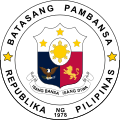| Interim Batasang Pambansa | |||||
|---|---|---|---|---|---|
| |||||
 | |||||
| Overview | |||||
| Term | June 12, 1978 – June 5, 1984 | ||||
| President | Ferdinand Marcos | ||||
| Prime Minister |
| ||||
| Deputy Prime Minister |
| ||||
| Batasang Pambansa | |||||
| Members | 189 | ||||
| Speaker | Querube Makalintal | ||||
| Speaker pro tempore | Datu Blah Sinsuat | ||||
| Majority leader | Jose Roño | ||||
| Minority leader | Hilario Davide Jr. | ||||
The Interim Batasang Pambansa (IBP) (English: Interim National Assembly) was the legislature of the Republic of the Philippines from its inauguration on June 12, 1978, to June 5, 1984. It served as a transitional legislative body mandated by the 1973 Constitution as the Philippines shifted from a presidential to a semi-presidential form of government.
Contents
- Sessions
- Leadership
- Legislation
- Major legislation
- Members
- Notes
- References
- External links
- Further reading
The IBP was preceded by the Interim National Assembly that briefly was the de jure body established in the original text of the 1973 Constitution, was never convened and effectively superseded by a series of nine constitutional amendments ratified through a referendum plebiscite held from October 16 to 17, 1976. [1]

